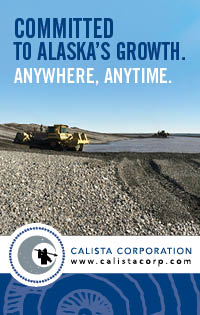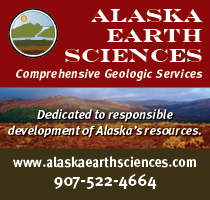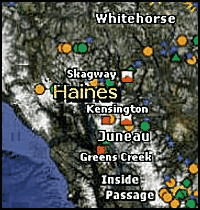Mining News: EPA doubles down on Bristol Bay study
 Click here to go directly to this story within the full PDF version of this issue, with any maps, photos or other artwork that appears in some of the articles. Click here to go directly to this story within the full PDF version of this issue, with any maps, photos or other artwork that appears in some of the articles.
Email it to an associate.
Pebble opponents urge agency to veto controversial copper project, D.C. lawmakers claim unprecedented measure oversteps authority
Shane Lasley Mining News
The second draft of U.S. Environmental Protection Agency’s Bristol Bay Assessment strengthens the notion that Pebble and other copper deposits in the Bristol Bay watershed are at risk of losing mining habitat due to the salmon population found there.
After spending about a year studying the area of Southwest Alaska where the enormous Pebble copper-gold-molybdenum project is located, EPA released the initial draft of the Bristol Bay Watershed Assessment in May, 2012.
Based on the critiques made by a 12-person peer-review panel and some 230,000 public comments, EPA bolstered the assessment, releasing a second draft on April 26.
Aside from dropping “Watershed” from the name, key changes to the revised assessment include: a better explanation of the hypothetical mine scenarios assessed; incorporation of modern conventional mining practices into mine scenarios and clarification that some of the projected impacts assume that those practices are in place and working properly; details about projected water loss and water quality impacts on stream reaches; and information on the potential ecological hazards related to the proposed transportation corridor.
“Generally, the updated assessment affirms the conclusions of the initial assessment,” EPA Region 10 Administrator Dennis McLerran said in a conference call coinciding with the April 26 release of the revised study.
These findings reaffirm that Pebble, the largest known copper-gold-molybdenum deposit on the planet, is situated in the Bristol Bay region of Southwest Alaska, home of an equally world-class sockeye salmon fishery.
The Alaska Miners Association and other resource development organizations in the state said the revised assessment did little to incorporate their recommendations.
Pebble opponents, on the other hand, found the second draft of the Bristol Bay Assessment an even stronger condemnation of developing the copper-gold-molybdenum deposit.
“The EPA study finds that the impacts of the Pebble Mine, at maximum size, would be even bigger than before,” said Kimberly Williams, director of Nunamta Aulukestai, a Southwest Alaska Native conservation group.
Pre-emptive veto Nunamta Aulukestai and fellow Pebble opponents such as Trout Unlimited are urging EPA to test the extent of its power under the federal Clean Water act by denying the Pebble Partnership the option of applying for permits to develop a mine at its world-class copper-gold-molybdenum deposit in the Bristol Bay region of Southwest Alaska.
“Pebble is far bigger and more threatening to renewable resource jobs than any other mine proposal in Alaska and it (is) planned for the worst location possible: the headwaters of Bristol Bay,” said Tim Bristol, director of Trout Unlimited’s Alaska Program. “Clearly, the time for action to protect Bristol Bay under the Clean Water Act is now.”
Under Section 404 of the Clean Water Act, the U.S. Army Corps of Engineers is charged with issuing permits for discharge into wetlands. Some 130 million acres of Alaska, about the combined area of California and Kentucky, are considered wetlands. Much of this vast expanse, including the Pebble property, is treeless areas of moist and wet tundra underlain by a permanently frozen layer that prohibits water drainage.
Although the Corps has been relegated the authority over the discharge permits on these wetlands, under section 404(c) EPA was granted the power to prohibit, restrict, or deny such permits that pose an unacceptable adverse impact to fisheries or other water uses.
While CWA Section 404(c) has never been used to deny a project the right to apply for permits, EPA claims it has the power to do so.
The anti-Pebble coalition petitioned the EPA to use this presumed veto authority under section 404(c) of the federal Clean Water Act to pre-emptively deny the Pebble Partnership discharge permits required to build a mine at the world-class copper-gold-molybdenum deposit.
Responding to the request, the environmental agency initiated the Bristol Bay Watershed Assessment to assess the salmon and other ecological resources in the region; gain a better understanding of the impacts of large-scale mining on these resources; and determine if this extraordinary stretch of its CWA authority is justified.
Pebble opponents believe such an extreme measure is warranted.
“Now, it’s time for the EPA to take immediate steps to protect Bristol Bay from the Pebble mine proposal and initiate the Clean Water Act’s 404c process,” said Nunamta Aulukestai Director Williams.
Characterizing the study as biased, costly and inherently flawed, the Pebble Partnership, a 50-50 alliance between Vancouver B.C.-based Northern Dynasty and London-based Anglo American, contends that its plans to develop the enormous copper project should be vetted within the United States’ already rigorous permitting process.
“The Pebble Partnership is simply asking for due process: the right to submit a permit application, and to have our plans reviewed, based on the best-available science and the relevant federal, state and local laws,” Shively commented.
With the goal of filing for permits by the end of the year, the Pebble Limited Partnership has agreed to a budget of roughly US$80 million for Pebble in 2013, which will push the total investment in the Bristol Bay area project to above US$750 million – with more than US$150 million of this spending on environmental research.
“At a time when the entire executive branch is having to cut important program funding because of sequestration, it is stunning that the EPA continues to pursue this matter instead of waiting for a permit application to review through the well-established regulatory process,” said Pebble Partnership CEO John Shively. “Even more disturbing is the fact that the EPA’s actions are consistent with the demands of those who want to deny the Pebble Partnership the right to submit a permit application.”
Both sides have until May 31 to submit their views to EPA.
D.C. lawmakers blast EPA Back in Washington D.C., a group of, mostly Republican, lawmakers on Capitol Hill are blasting the EPA for its involvement in a mining project that has yet to apply for permits – charging that the Bristol Bay Assessment is inappropriate and a preemptive veto of the Pebble project would overstep the environmental agency’s legal authority.
“If the EPA has concerns about the impact of a project there is an appropriate time to raise them – after a permit application has been made, not before. It is clear to me that a preemptive veto of resource development is quite simply outside the legal authority that Congress intended to provide to of the EPA. I made that clear to the previous EPA administrator and I will make it clear to the current nominee, Gina McCarthy,” said Sen. Lisa Murkowski, R-Alaska, in response to the revised assessment.
Alaska’s senior senator is not the only one on Capitol Hill who is alarmed by EPA’s tactics.
Sen. David Vitter, R-Louisiana, top Republican on the Environment and Public Works Committee, said, “EPA is playing a dangerous game, using hypothetical situations to shut down job creation.”
In a February letter to EPA acting administrator Robert Perciasepe, Vitter and Sen. Roger Wicker, R-Mississippi challenged the EPA’s authority to preemptively veto the Pebble Mine Project.
“Specifically, we are deeply troubled by EPA’s unreasonable claim that it has ‘pre-emptive veto authority’ over the Pebble Mine Project before the sponsor has the opportunity to apply to the Army Corps of Engineers for a CWA permit. Such an interpretation is unreasonable and contrary to both plain text of the CWA and its legislative history,” penned the pair of Republican senators.
Vitter and Wicker also laid out their cases to the temporary administrator.
House Committee on Oversight and Government Reform Chairman Darrell Issa , R-California, who has been trying to get the EPA to turn over records associated with the Bristol Bay Assessment for more than a year, has threatened to subpoena the agency to get the long past-due documents.
In April, Vitter joined Rep. Issa in his attempt.
In a letter to Gina McCarthy, who has been nominated but not confirmed to become EPA’s next administrator, the Republican lawmakers wrote, “To date, the agency has fallen woefully short of enforcing these federal records laws and responding to our inquiries. Notably, our investigation revealed that EPA employees, including you, have operated in a manner that disregards internal protocols and inhibits the public’s right to information in a potential effort to evade transparency.”
Withheld information in regards to EPA’s involvement in the Pebble project is among the documents the pair of lawmakers asked McCarthy to turn over.
Tainted assessment? As lawmakers press the EPA to be forthright about its study of the Bristol Bay watershed, a Washington, D.C.-based research group questions whether the involvement of an environmental consulting firm that has admitted in a U.S. federal court to filing falsified reports has tainted the assessment.
“We’re concerned that EPA could stop the development of what may be the largest-ever domestic copper resource before the permitting process has begun – and based on research presented by authors who have admitted falsifying their findings in other environmental studies,” said American Resources Policy Network President Daniel McGroarty.
Stratus Consulting, which was involved in authoring two reports associated with the Bristol Bay Assessment, also produced assessments that were used to win a US$19 billion judgment against Chevron in Ecuadorian court.
Charging that Stratus falsified its reports, Chevron sued the environmental research firm for fraud and racketeering. In an April 11 response to the suit, Stratus published a 28-page affidavit accompanied by 16 pages of individual declarations disavowing the environmental assessments.
McGroarty May 6 delivered a letter to Sen. Vitter and Senate Committee on Environment and Public Works Chair Barbra Boxer, urging them to investigate EPA’s relationship with Stratus.
“We were concerned by the news of this admission, as public records show that the EPA has multiple active contracts with Stratus Consulting collectively worth up to tens of millions of taxpayer dollars,” said McGroarty.
ARPN is particularly troubled by Stratus’ contributions to the EPA’s recently released draft Bristol Bay Assessment.
“We also discovered that several research reports authored by Ann Maest, managing scientist for Stratus Consulting – who played a key role in producing and personally disavowing the falsified research in Ecuador – are currently being used to support a major environmental assessment by the EPA.”
According to research conducted by ARPN, the Bristol Bay Assessment cites two non-peer-reviewed documents – Kuipers et al. (2006) and Wobus et al. (2012) – co-authored by Maest.
Noting that these reports had not been previously vetted, the EPA had an internal peer-review conducted on these and five other documents.
Concluding its internal peer-review process, the EPA said “the reports are of ‘sufficient scientific quality and credibility’ to be incorporated into the second external review draft of the Bristol Bay Assessment.”
David Atkins, EPA’s top-listed peer-reviewer of the Kuipers report, is a former managing scientist for Stratus Consulting – the same position currently held by Maest, author of the report. Atkins also sits on the 12-person panel charged with peer-reviewing the Bristol Bay Assessment.
The Center for Science in Public Participation, a conservation group that is involved with the attempt to convince EPA to veto the permits to develop Pebble, credits Maest for providing technical support on geochemistry and hydrology used in its stance against development of the Southwest Alaska copper project.
| 
 Click here to go directly to this story within the full PDF version of this issue, with any maps, photos or other artwork that appears in some of the articles.
Click here to go directly to this story within the full PDF version of this issue, with any maps, photos or other artwork that appears in some of the articles.
























